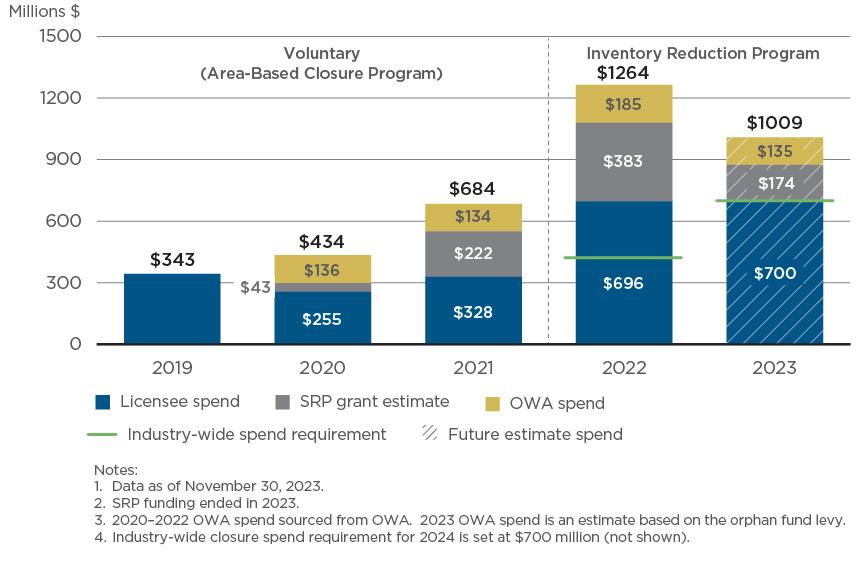January 2024
When closure work (decommissioning, environmental site assessment, remediation, and reclamation) is completed, industry reports the costs to the AER. We have collected industry closure spend data through the voluntary area-based closure (ABC) program from 2019 through 2021, and we continue to collect this data through the new industry-wide closure spend requirement in 2022. See below for links to these highlight reports.
In 2022, as part of the inventory reduction program, the industry-wide closure spend requirement was set at $422 million. There are three ways in which licensees achieve compliance with the mandatory closure spend quotas:
- They spend sufficient money to meet or exceed the quota.
- They opt to provide security in lieu of closure spend (available to licensees with spend quota of less than $50K).
- They provide security for the difference between their mandatory closure spend quota and their closure spend reported.
Industry reported eligible spending of $696 million, exceeding the requirement by 65%. A further $185 million in closure work was completed by the industry-funded Orphan Well Association and an estimated $383 million in funding came from the Government of Alberta’s Site Rehabilitation Program grants.
In total, over $1.2 billion was spent on closure work in 2022.
Figure 7. Total closure spend and future industry-wide spend requirements, 2019–2023

In 2022, licensees primarily focused closure on decommissioning work (56% of reported closure dollars). Licensees spent $63 million on environmental site assessments, $145 million on remediation, and $255 million on reclamation activities.
Figure 8. Closure spend by closure activity, 2022

For the 2022 mandatory closure spend quota, 90% of licensees were compliant. There were 51 noncompliant licensees with an outstanding amount of $4.2 million in missed quotas (1% of industry-wide closure spend requirement).
Table 1. Licensee Closure Quota Compliance 2022
Notes:
- Definitions of compliance are available in Manual 023. If a company does not reach its closure quota via closure work or security payment, they are deemed noncompliant.
- Only licensees receiving a 2022 quota appear in this table.
- Licensees with 0% of quota met and closure spend breakdowns is due to SRP funding they received. SRP funding does not count towards licensees’ mandatory closure spend quotas.
- Data as of December 5, 2023.
Glossary
Decommissioning
This stage involves the permanent closure of a well or facility. Typically referred to as abandonment in our directives, decommissioning activities involve the safe and permanent closure of the well or facility, including the plugging of wells, the removal of equipment and other measures to ensure the site is safe and environmentally sound.
Environmental site assessment
Environmental Site Assessments are conducted to evaluate the environmental condition of a site in relation to substance releases (contamination) and determine if remediation is required.
Remediation
Remediation (decontamination) activities involve reducing, removing, or destroying substances in soil, water, or groundwater through the application of physical, chemical or biological processes.
Reclamation
Once a well or facility has been decommissioned and the site has undergone necessary environmental site assessment and, if necessary, remediation (decontamination) and reclamation activities to meet regulatory standards, it is considered reclaimed. Reclamation aims to restore the land to a state as close as possible to its pre-development condition.


